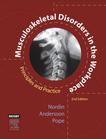工作场所中的骨骼肌损伤
2006-8
Elsevier Science Health Science div
Nordin, Margareta (EDT)/ Andersson, Gunnar B. J. (EDT)/ Pope, Malcolm H. (EDT)/ Leger, Dawn, Ph.D. (EDT)/ Burwell, Cristina Mickley (ILT)
428
Completely revised and updated, the 2nd Edition of this respected reference covers both the theoretical background and the clinical managementas well as the biomechanics and ergonomicsof orthopedic injuries occurring in the workplace. · Emphasizes the prevention of disability. · Offers expanded coverage of specific disorders · new topics, including whiplash · and a new section on outcome evaluation. · Includes Workplace Adaptations with Case Studies in every body segment chapter. Features several new chapters: Functional Capacity Testing · Disability Evaluation · Treatment Options for the Wrist and Hand · Evaluation of the Neck · and Epidemiology of the Neck.
Margareta Nordin, Dr.Med.Sci., New York University Medical Center, New York, NY; Gunnar B. J. Andersson, MD, Professor and Chairman, Department of Orthopedic Surgery, Rush-Presbyterian-St. Luke's Medical Center, Chicago, IL; and Malcolm H. Pope, Dr. Med, Sc, PhD;, Professor, University of Aberdeen Head od Department of Bio-Medical Physics and Bio-Engineering, Grampian University Hospitals Forester Hill, Aberdeen, Scotland
PART I:INTRODUCTION Chapter 1:Introduction to Epidemiologic Concepts in Musculoskeletal Disorders Chapter 2:Psychosocial Aspects of Work-Related Musculoskeletal Disorders:Clinical ImplicationsPART II: MUSCULOSKELETAL DISORDERS Section A:The Spine Chapter 3:Neck 3a.A Review of the Epidemiology of Neck Pain in Workers:Prevalence,Incidence,and Risk Factors 3b.Biomechanics of the Cervical and Thoracic Spine 3c.Evaluation of the Neck 3d.Treatment Options for Disorders of the Cervical Spine 3e.Workplace Adaptation Chapter 4:Lower Back 4a.Epidemiology:Incidence,Prevalence,and Risk Factors 4b.Clinical Biomechanics of the Spine 4c.Initial Evaluation of the Low Back Region 4d.Treatment Options 4e.Workplace Adaptation for the Low Back Region Section B:The Upper Extremity Chapter 5:Shoulder and Elbow 5a.Shoulder and Elbow Disorders 5b.Biomechanics of the Shoulder and Elbow Complex 5c.Evaluation of the Shoulder and Elbow 5d.Treatment of Shoulder Disorders 5e.Workplace Adaptation for Shoulder Disorders Chapter 6:Wrist and Hand 6a.Epidemiology of Wrist and Hand Disorders 6b.Biomechanics of the Wrist and Hand 6c.Functional Evaluation of the Wrist and Hand 6d.Wrist and Hand:Treatment Options 6e.Biomechanical Aspects of Hand Tools Section C:The Lower Extremity Chapter 7:Hip and Knee 7a.Epidemiology of the Lower Extremity 7b.Biomechanics of the Hip and the Knee 7c.Clinical Evaluation of the Hip and Knee 7d. Hip and Knee:Treatment Options 7e.Workplace-Related Lower Extremity Disorders:Workplace Adaptations with Case Studies Chapter 8:Ankle and Foot 8a.Epidemiology of the Ankle and Foot 8b.Anatomy and Biomechanics of the Ankle and Foot 8c.Foot and Ankle Disorders in the Workplace 8d.Treatment and Indications for Surgical Treatment of Fot and Ankle Injuries 8e.Adaptation of Workers with Foot and Ankle Disorders to the Workplace:Case StudiesPART III:ABILITY EVALUATION Chapter 9:Functional Performance Testing Chapter 10:The Physician's Role in Disability Evaluation
